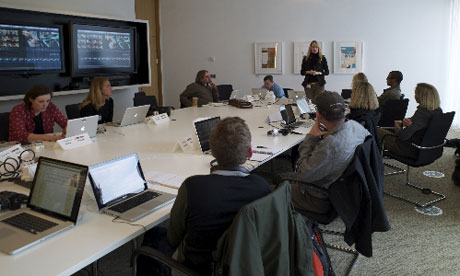
Last week we trained 18 people to shoot, edit and produce video at theGuardian Media Academy. In that same week, another 254 people joined www.nyvs.com, our online video training site.
That’s not a lot when you consider the magnitude of what we are trying to accomplish. This is not about teaching people to make video. This is a revolution in literacy – video literacy.
We are, today, a society that is defined by video. It is, for better or for worse, the lingua franca of our culture. The average American or European spends five hours a day watching videos, either on TV or online. That number is primed to get much bigger as video migrates to the web.
Video is the way that we, increasingly, communicate stories, news, information and even ideas to one another. It’s powerful because it often transcends barriers of language and of culture. It is universal and powerful. It drives everything from politics to religion, and much in between.
Yet the vast majority of the population (on the order of 99.99%) is and remains largely video illiterate. That is, while they can watch video, they cannot create it. It means they’re cut off from participating in creating the very elements of our public discourse, as well as our entertainment. They are, in effect, second-class citizens.
What’s worse is that we are all the poorer as a culture when we place this incredibly powerful medium in the hands of a select (or self-selected) few. It’s a crazy and terribly destructive thing to do.
So no, we are not teaching people a skill; we are teaching them to participate in the formation of our culture, instead of being simply passive observers. There’s an old printing press in the main hall of the Guardian’s offices at Kings Place. It’s an interesting choice of decoration.
The morning after the printing press was invented in 1452, there was almost no one in Europe who was literate. Literacy was then the purview of a tiny and elite fraction of the population. The great and vast majority of the world was incapable of reading and writing.
So while the printing press was a wonderful machine for democratising learning and ideas, it had to go hand and hand with a rather rapid process of teaching people to read and write, and empowering them with the idea that they could do this, that it was, in fact, both their right and responsibility.
This transformation took several hundred years, and not an insignificant amount of blood was shed in its defence.
Today, we live in a world where print literacy – the ability to read and write – is viewed as a fundamental unifying principle of our culture. We teach people to write in school, not in the hope they might one day earn a living as writers, but so they might fully contribute to culture as a whole.
Now, as we move rapidly from a print-based to culture to a video-based culture, it’s equally important that we teach people how to communicate their ideas in video. Not so that they might one day earn a living as cameramen (though they might), but so that they might craft their ideas in the medium in which we are all increasingly communicating.
Michael Rosenblum is CEO at Rosenblum TV. See a video showcase form his recent four-day intensive video training bootcamp here – follow him on Twitter @Rosenblumtv
This content is brought to you by Guardian Professional. To get more articles like this direct to your inbox, sign up free to become a member of the Guardian Media Network.